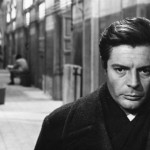Zurlini celebrato al Filmmuseum

I Mille Occhi sono lieti che l'omaggio triestino a Zurlini stia avendo dei seguiti tra cui Bologna e Vienna. Il Filmmuseum austriaco, in collaborazione con l'Istituto italiano di cultura a Vienna e Cinecittà luce celebra in parallelo l'intera produzione artistica di due autori del cinema italiano tra dopoguerra e boom economico: Valerio Zurlini e Antonio Pietrangeli. La retrospettiva viennese a loro dedicata si terrà dal 10 gennaio al 3 febbraio.
The work of Valerio Zurlini (1926-82) appears like a remote archipelago off the mainland of Italian post-war cinema - a scattered group of works that form a world apart, yet which are still very much in touch with the spirit and the trends of their time. Zurlini was a loner and his great themes are loneliness and abandonment. His vision often exceeded the capacity and courage of Italian cinema (even during its most powerful period). From Il paradiso all'ombra delle spade, his "unproduceable" magnum opus of which the first sketches had already appeared in the early 1960s, Zurlini was only able to complete the final episode: La prima notte di quiete (1972). Il paradiso ... was the great nexus of themes and images to which Zurlini would return again and again after his breakthrough with Estate violenta (Violent Summer, 1959); it was the source of his inspiration. Viewed from this perspective, Zurlini's oeuvre can never be "complete."
A key reason for the small number of realized works is to be found in Zurlini's meticulous and uncompromising nature - he demanded what his projects needed. This was not necessarily more money, but more time. For example, his "Passion of Lumumba Among the Mercenaries," Seduto alla sua destra (1968), was planned as an episode of the omnibus film Amore e rabbia, but then developed into a full-length work - without using much more of a budget than was allotted for the 30 minute piece. At first glance, it seems that 30 minutes would have been enough time to tell that story. Upon seeing the finished film, however, one realizes that what matters cannot always be captured in a script - how long a movement lasts, the gestures of the actors, the slow rolling rhythm of waiting for death. Not that Zurlini's films were lengthy - Le soldatesse (1965), for example, was edited down from three to two hours by Zurlini himself, eliminating a lot of moralistic back and forth and many narrative transitions, in order to emphasize the importance of several key moments. Thus, the minutes that pass sometimes feel as enormous as a lifetime.
Zurlini understood early on that time is a valuable and fragile commodity: in 1943, fresh out of school, he joined the Corpo Italiano di Liberazione. He was 19 when peace was declared. Originally attracted to the theater and working as an assistant at the Piccolo Teatro in Milan, he came to Rome in 1949 and immediately switched to movies. That same year, he made the first of ten short films which quickly established his reputation. His first feature, Le ragazze di San Frediano (1954), was a singularly bitter exercise in the comedic discipline of neorealismo rosa. However, Zurlini considered his second film, Estate violenta, to be his true debut - in many ways it was an autobiographical film about his own youth. With Estate violenta, Zurlini also established his great themes: memory, waiting, and war. His following work, La ragazza con la valigia (Girl with a Suitcase, 1961) became his biggest success: a film completely of the moment, full of the sense of drifting and a double-edged youthfulness that marked the peak of the Italo-Boom. His highest official honor followed shortly thereafter with Cronaca familiare (1962), which shared the Golden Lion in Venice with Andrej Tarkovsky's Ivan's Childhood.
At that point, Zurlini was 36 years old. Who would have believed that he would make only four more films, and that the remaining two decades would bring mostly rejection? That in order to make a living, he would be forced to accept TV work, return to the theater, and even find himself directing voice-dubbing sessions? Zurlini's last film stands as a summation of his life's work, as if he knew how little time remained. Here, in Il deserto dei Tartari (The Desert of the Tartars, 1976), the endurance of soldiers at the borders of the known world is wondrously recognized, as the thing that no one had dared to hope for anymore finally happens. And the lives of all those lost in silent service are finally honored.
The retrospective is organized in collaboration with Cinecittà Luce and the Italian Cultural Institute in Vienna.
imilleocchi newsletter
Privacy Policy per i visitatori del sito
Secondo quanto previsto dalla Legge 124/2017, l'Associazione Anno uno rende pubblici online gli importi di natura pubblica ricevuti nel 2018.







